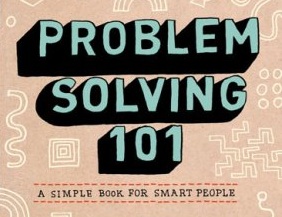Last Updated on 11 August 2019
One of my favorite books about problem-solving is Ken Watanabe’s best-selling book, Problem-Solving 101.
In this article, I outline Watanabe’s lesson for finding the root cause of a problem – a key concept. But, before I get into the details, let’s first talk big picture…
What Is Problem-Solving?
What the heck is problem-solving or creative problem-solving anyway?
It’s simply a process of key steps to help – when you have a problem – to understand the problem, think-up potential solutions, and make a decision.
We are problem solvers every day of our life, from parallel parking to figuring out ways to trim your FY’10 budget. Many of our problems are small and involve little risk. For these, we can instantly perform problem-solving steps in our head.
However, when greater risk is involved… for example when it involves big sums of money, significant impact on an organization, or irreversible consequences… these problems need to be “worked” and broken into smaller chunks and run through a step-by-step process. That process is taught in Problem Solving 101.
While different people break the steps into different chunks, the 4-steps Ken outlines are:
- Understand the situation.
- Identify the root cause of the problem.Idea Sandbox focuses on brainstorming and decision-making in order to have great ideas for your plan.
- Develop an effective action plan.
- Execute, and modify, until the problem is solved.
The benefits of having a process for problem-solving? As Ken states in the book, “Rather than feeling as though your life is out of control, you can take charge and shape the world around you. Your dreams and goals will seem less out of reach. And you’ll be better able to accomplish whatever you’re passionate enough and imaginative enough to conceive and pursue.”
The book was originally written to provide kids in Japan with better problem solving and decision-making skills. However, it quickly became a huge success among adult, business leaders.
Translated into English the book is still the perfect read for a younger audience, but also happens to be one of the best primers for adults who need to strengthen their problem-solving skills.
Who needs this book?
This book will be helpful if you’ve got this kind of person at work or school…
Ken could have easily done what most other books do…
Present sample case studies featuring Company XYZ selling their widgets. Describe to us their challenges in building awareness and driving sales. And he would have used a generic image like below…
We’ve got problems with the widgets, Ted.Instead, he chose – for one example – a school band wanting more students to be aware and attend their concerts with original illustrations by Allan Sanders.
While some may say this book is too basic for US business leaders… I’ll argue… If Who Moved My Cheese can be a #1 best seller with the annoyingly simple parable featuring the complainers Hem and Haw, and the smart mice Sniff and Scurry, there is a place for Problem Solving 101.
Lessons from Problem Solving 101
One of the models Ken presents is how to determine Root Cause Of Problems, and how to overcome them.
Determining Root Cause
Step 1: Diagnose the situation and identify the root cause of the problem.
- List all the potential root causes of the problem.
- Develop a hypothesis for the likely root cause.
- Determine the analyses and information required to test the hypothesis.
- Analyze and identify the root cause.
Step 2: Develop the Solution
- Develop a wide variety of solutions to solve the problem.
- Prioritize actions.
- Develop an implementation plan.
If you’re not familiar or need a refresher into using the problem-solving tools (below), this books is for you.
- Logic Tree
- Yes/No Tree
- Problem-Solving Design Plan
- Hypothesis Pyramid
- Pros and Cons; Criteria and Evaluation
Problem-Solving 101 is a great step-by-step process that is easy for anyone to follow.






